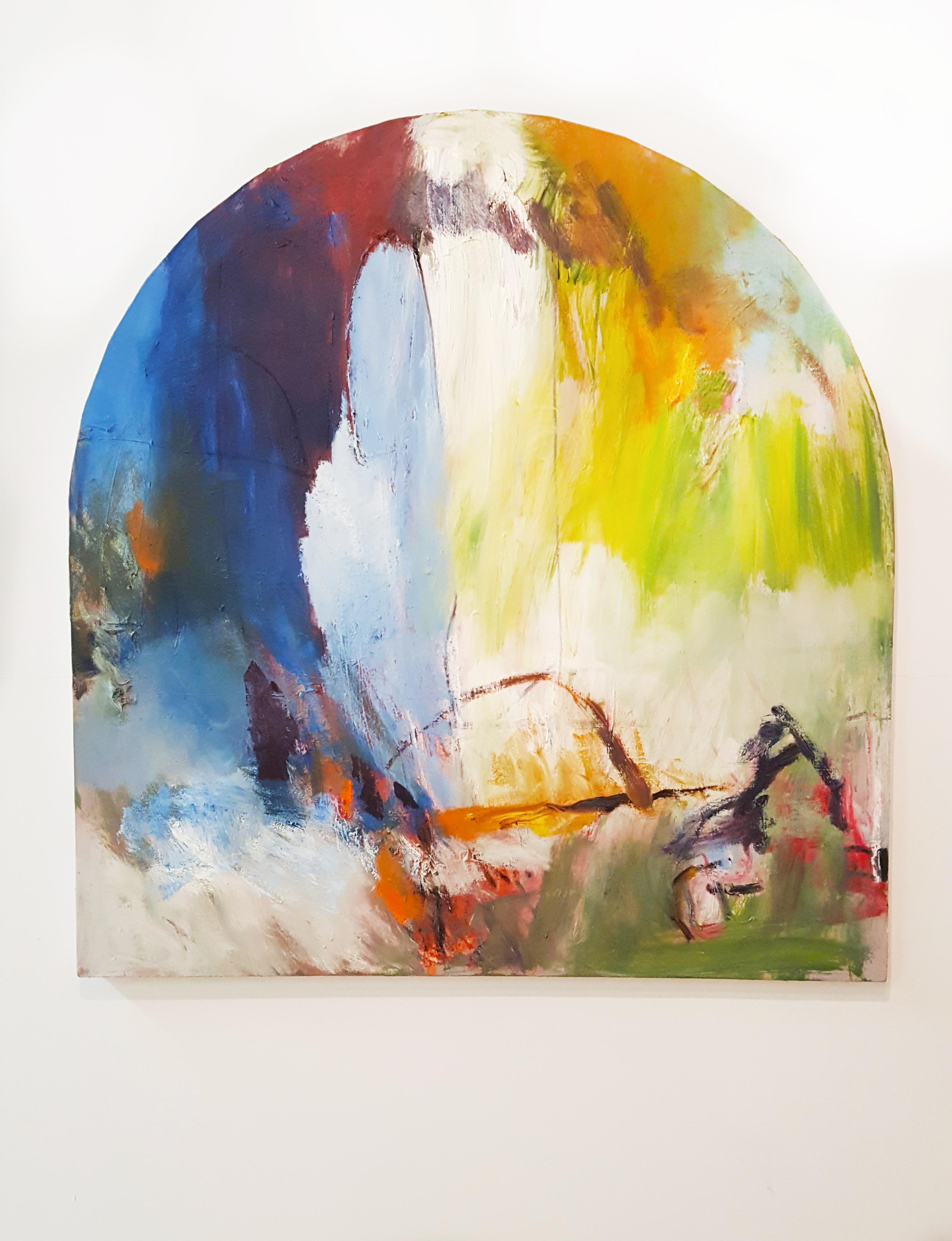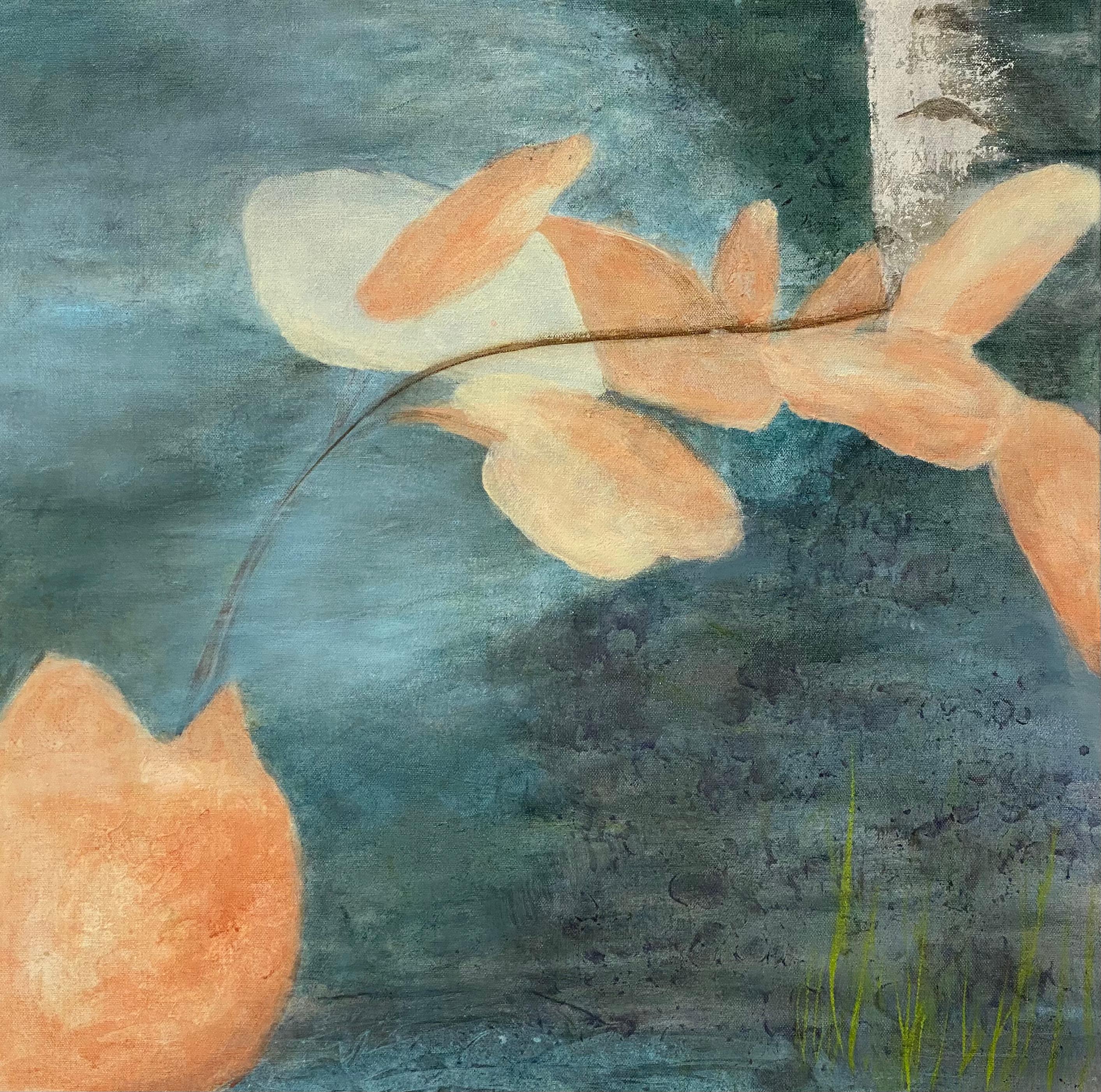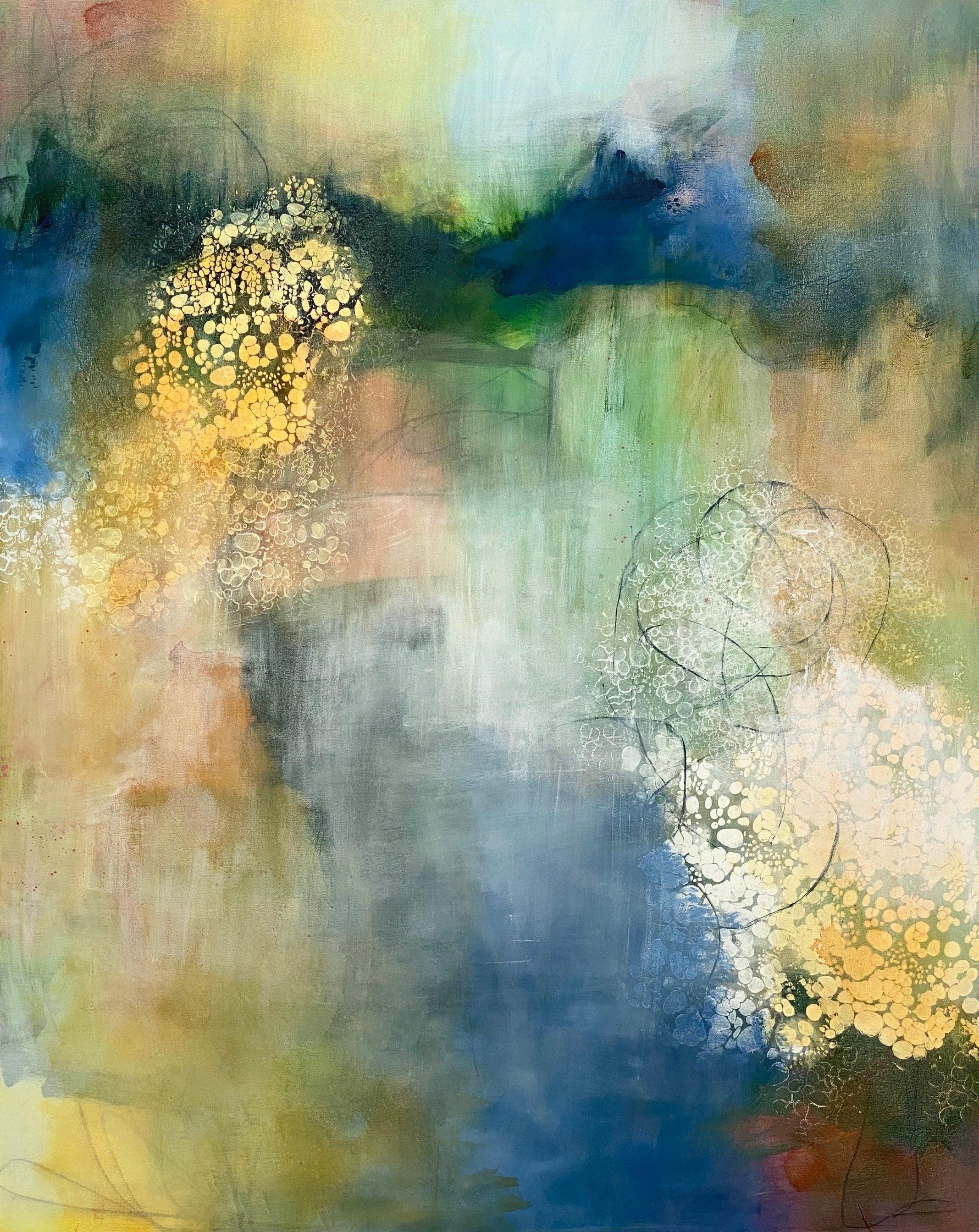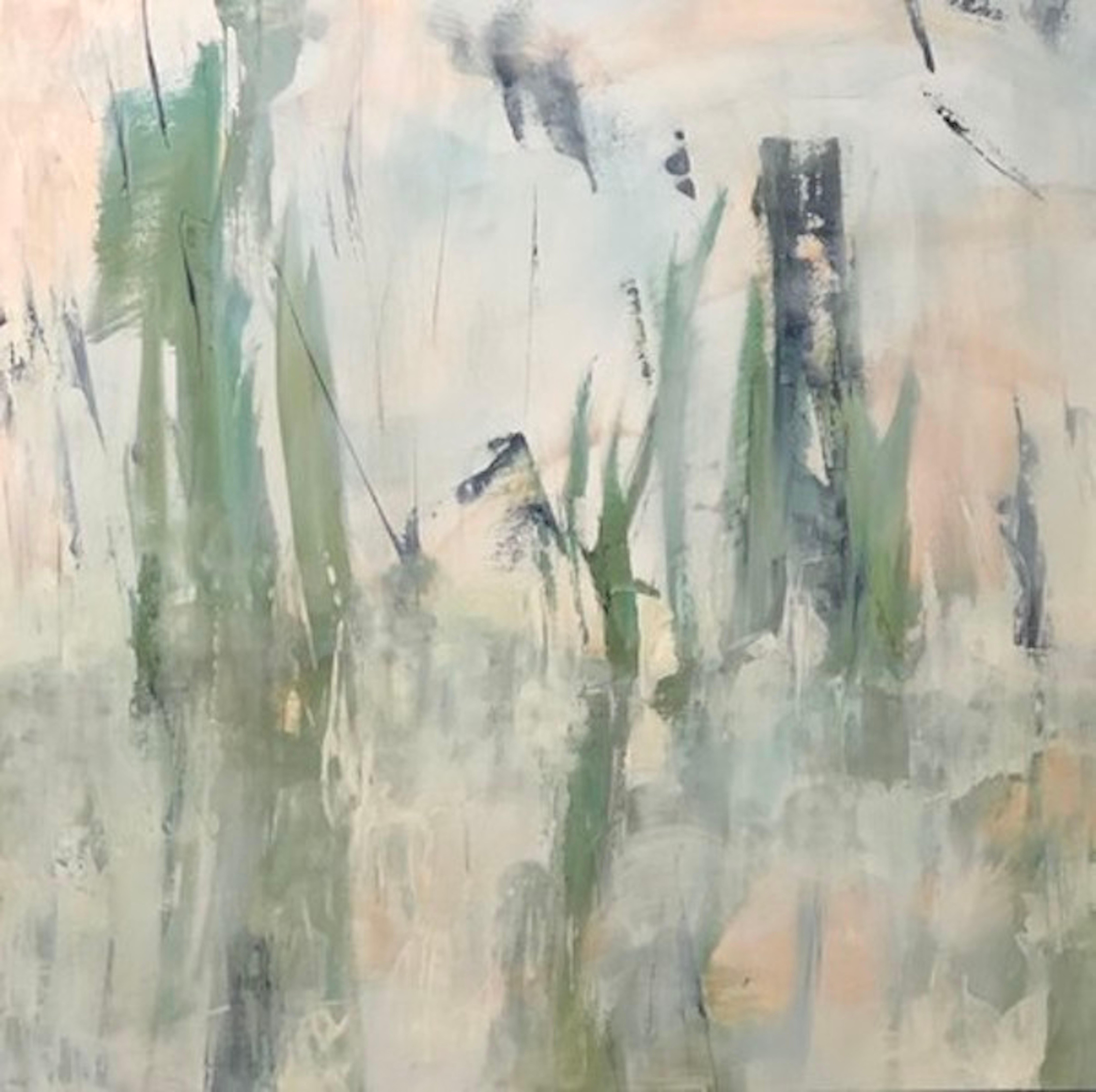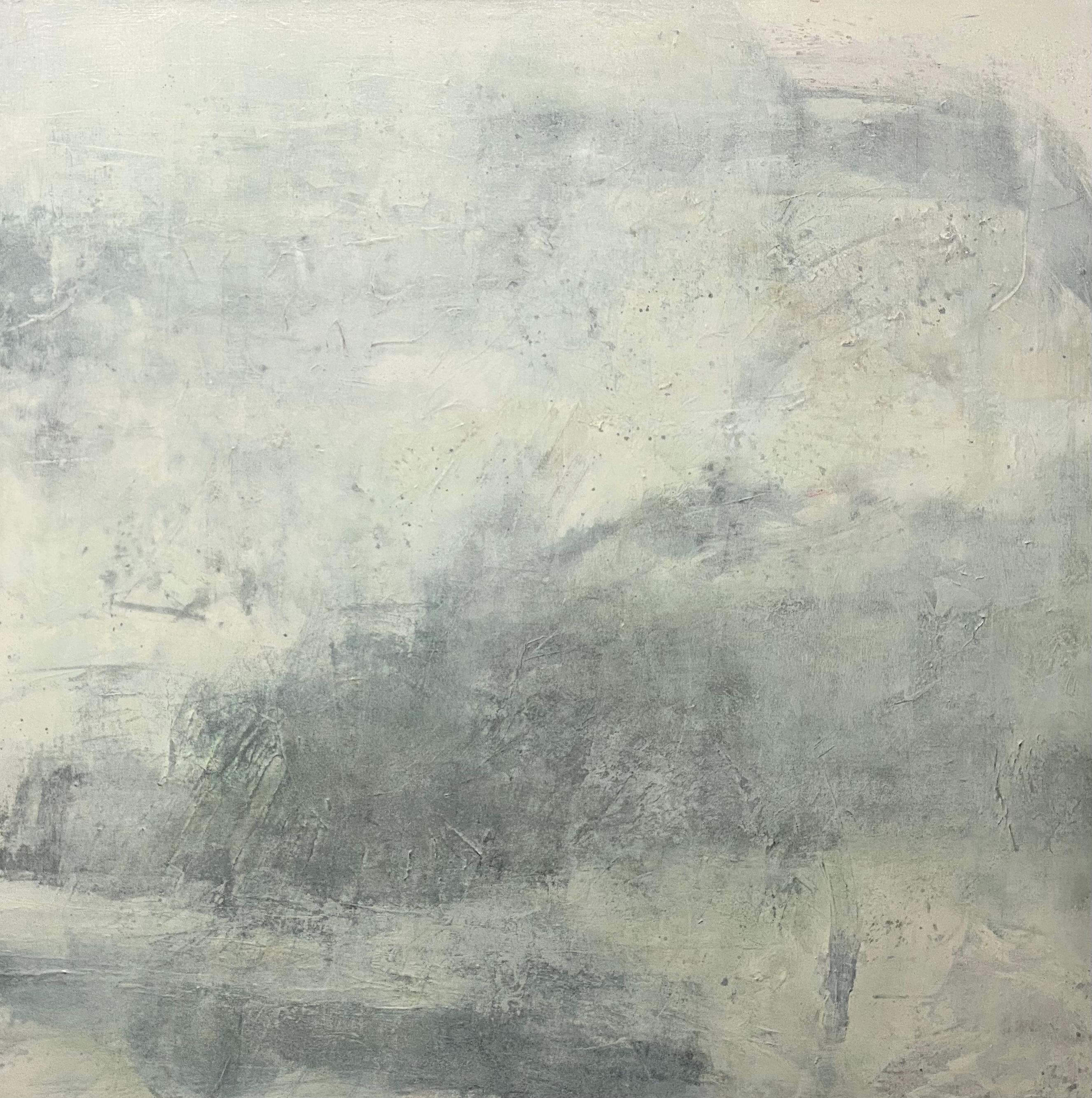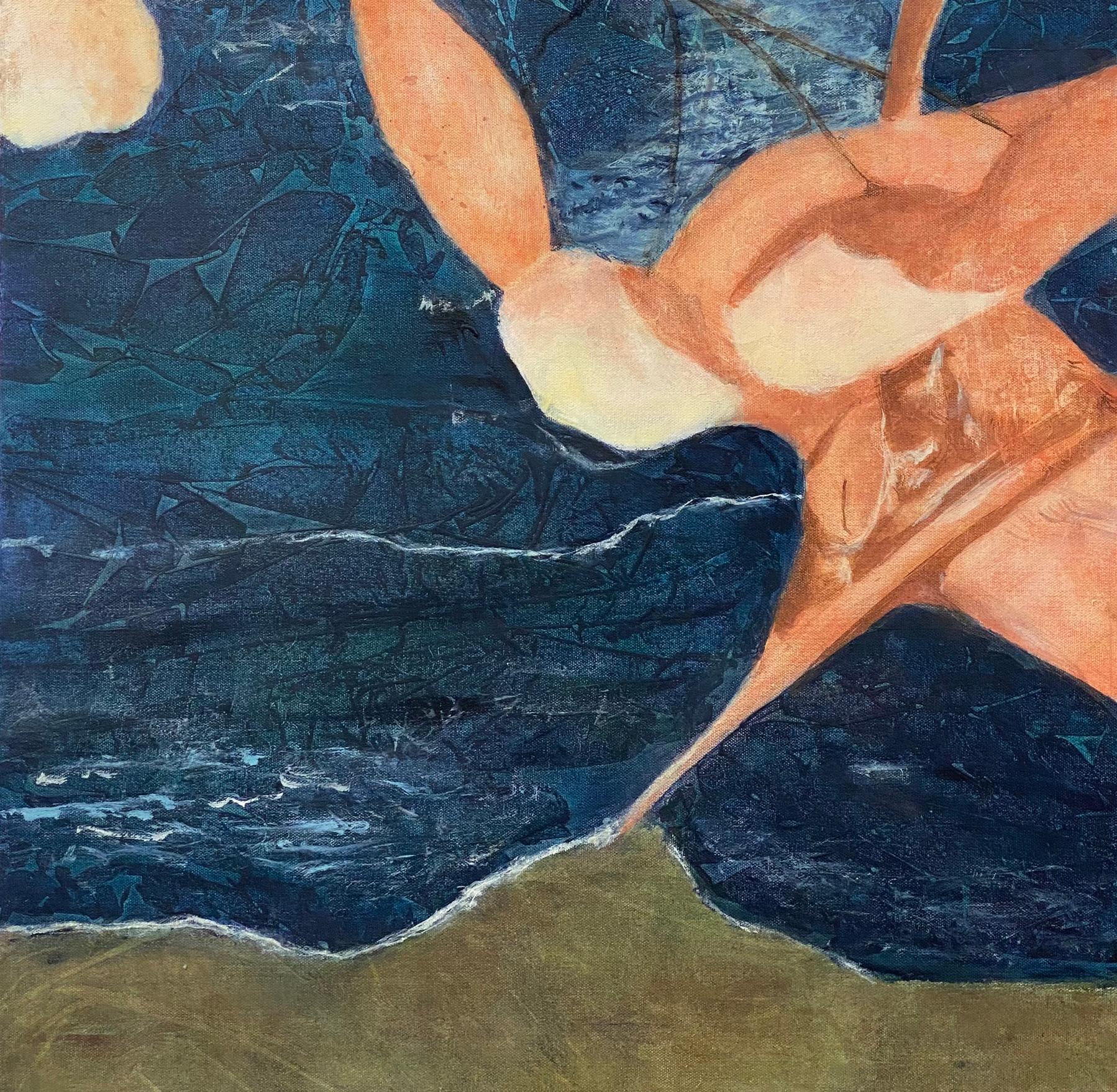Items Similar to Abstract Flora III: Minimalist Abstract Landscape of Dark Silver & Bronze Leaves
Video Loading
Want more images or videos?
Request additional images or videos from the seller
1 of 11
Frank FaulknerAbstract Flora III: Minimalist Abstract Landscape of Dark Silver & Bronze Leavesc. 2010
c. 2010
About the Item
Abstract landscape of a floral leaf motif with a patina of dark silver and dark bronze
"Abstract Flora III", painted by Frank Faulkner, c. 2010
60 x 48 x 1.5 inches, acrylic on wood panel
Wire backing for secure installation
Signed, verso
This minimalist abstract landscape was painted by Frank Faulkner in 2010-12. The artist captures a scene of an abstract floral motif with long leaves that fan outwards. The subject in the center is framed with a vignette of dark fern leaves around the edges of the painting. The floral motif and leaves are constructed with built up acrylic that creates an impasto surface, similar to a relief. The painting is unframed and the edges reveal drips from the layers of paint applied the surface.
More about the work:
Revered artist and designer Frank Faulkner was well known among locals for his handsome restorations of prominent historic proprieties on Hudson’s Warren Street and beyond. It is apparent that the applied arts like classical architecture, Persian rugs, chinoiserie, and Samurai armor greatly influenced his own painting style. His technique employs a rich variety of texture and color evoking the qualities of mosaics and tapestry. According to the artist, the paintings on view experiment with representational imagery. Central designs are positioned in spaces suggestive of landscapes where the settings utilize horizon lines and natural, atmospheric light. Organic compositions take their cues from natural flora endowed with fantasy, which intentionally disorient the viewer. These works present the argument for the imaginary versus the empirical world.
About the artist:
Born in Sumter, South Carolina in 1946, Frank Faulkner received his B.F.A. from the University of North Carolina in 1968, Phi Beta Kappa, and his M.F.A. from the same institution in 1972. Faulkner’s work quickly won him numerous grants and awards, including an individual artist grant from the National Endowment for the Arts in 1974. He was selected for the Whitney Biennial in 1975, which prompted him to settle in New York. There, he came to the attention of Dorothy Miller, Curator Emeritus of the Museum of Modern Art with a legendary eye for new talent. Since then, Faulkner has continued to garner acclaim and awards. He has been featured in dozens of one-person exhibitions (not to mention group exhibitions) in this country, as well as in Japan, Switzerland, and Germany.
Faulkner’s work is owned by leading museums (the Smith College museum in Northampton, Massachusetts, for example, the National Museum of American Art and the Hirshhorn in Washington, D.C.) and by renowned collectors such as Nelson Rockefeller, Baron Leon Lambert, Phillip Hanes and Abba Eban.
What a viewer first notices is the sheer elegance of the pieces, no matter what materials Faulkner uses—metal, wood and fabric as well as canvas and paper. Obvious, too, is the artist’s originality. Faulkner belongs to no school. His work is patterned but is far too intellectual to qualify as so-called “pattern art,” which mainly strives to be merely pretty. Rather, he paints in his own highly organized way, filling the surface without being excessive or boring.
Faulkner sets up a system, say, of dots or dashes, then subtly changes the visual rhythms in order to add life and surprise—what he calls “the gymnastics of seeing.” He works and reworks the surfaces of his canvases, often laying down one thin layer of slightly reflective gold, silver or bronze paint upon another until the final work seems to glow with inner light. John Ashbery, a leading critic and poet, has likened Faulkner’s art to minimalist music, which achieves both simplicity and beauty from its obsessive repetitions. The critic Carter Ratcliff describes it more simply as “brilliant artifice.” Faulkner’s current work, a series of paintings on paper, continues and deepens this exploration of the relationship between wrought surface and changing light.
Another striking aspect of the work is the influence of the decorative arts. Faulkner has made some paintings on wood that stand independently and fold open like screens. Other pieces resemble large tapestries, and yet others take their inspiration from Art Nouveau inlays. Faulkner is quick to admit his sources. To him, the applied arts are indistinguishable from the fine art. He knows and loves Samurai armor, Classical architectural details, chinoiserie, Persian rugs—the whole gamut of the applied arts—and they, of course, inform his creations. Indeed, he is so interested in interiors that he has, while continuing to paint, spent much of the last decade restoring old houses and advising clients how to decorate their homes. (Many of the results have been featured in periodicals such as Architectural Digest and House & Garden.)
Philip Herrera, June 2006
- Creator:Frank Faulkner (1947, American)
- Creation Year:c. 2010
- Dimensions:Height: 60 in (152.4 cm)Width: 48 in (121.92 cm)Depth: 1.5 in (3.81 cm)
- Medium:
- Movement & Style:
- Period:
- Condition:
- Gallery Location:Hudson, NY
- Reference Number:1stDibs: LU2277981852
About the Seller
5.0
Platinum Seller
These expertly vetted sellers are 1stDibs' most experienced sellers and are rated highest by our customers.
Established in 1991
1stDibs seller since 2013
540 sales on 1stDibs
Typical response time: 2 hours
- ShippingRetrieving quote...Ships From: Hudson, NY
- Return PolicyA return for this item may be initiated within 3 days of delivery.
More From This SellerView All
- Chasm: Abstract Landscape Painting of Gold and Bronze Leaves on BlackBy Frank FaulknerLocated in Hudson, NYAbstract landscape of fern leaves in a dense forest painted in dark gold and bronze against black and muted turquoise "Chasm", painted by Frank Faulkner, c. 2007 60 x 48 x 1.5 inches, acrylic on wood panel Wire backing for secure installation Signed, verso This minimalist abstract landscape was painted by Frank Faulkner in 2007. The artist captures a scene of an abstract floral motif of gilded fern leaves in dark gold and bronze against a dark forest landscape. The floral motif and leaves are constructed with built up acrylic that creates an impasto surface, similar to a relief. Silhouettes of hands painted in black and white polka dots are captured behind several of the leaves, further accentuating the painting's alluring textural quality. The painting is unframed and the edges reveal drips from the layers of paint applied the surface. More about the work: Revered artist and designer Frank Faulkner was well known among locals for his handsome restorations of prominent historic proprieties on Hudson’s Warren Street and beyond. It is apparent that the applied arts like classical architecture, Persian rugs, chinoiserie, and Samurai armor greatly influenced his own painting style. His technique employs a rich variety of texture and color evoking the qualities of mosaics and tapestry. According to the artist, the paintings on view experiment with representational imagery. Central designs are positioned in spaces suggestive of landscapes where the settings utilize horizon lines and natural, atmospheric light. Organic compositions take their cues from natural flora endowed with fantasy, which intentionally disorient the viewer. These works present the argument for the imaginary versus the empirical world. About the artist: Born in Sumter, South Carolina in 1946, Frank Faulkner received his B.F.A. from the University of North Carolina in 1968, Phi Beta Kappa, and his M.F.A. from the same institution in 1972. Faulkner’s work quickly won him numerous grants and awards, including an individual artist grant from the National Endowment for the Arts in 1974. He was selected for the Whitney Biennial in 1975, which prompted him to settle in New York. There, he came to the attention of Dorothy Miller, Curator Emeritus of the Museum of Modern Art with a legendary eye for new talent. Since then, Faulkner has continued to garner acclaim and awards. He has been featured in dozens of one-person exhibitions (not to mention group exhibitions) in this country, as well as in Japan, Switzerland, and Germany. Faulkner’s work is owned by leading museums (the Smith College museum in Northampton, Massachusetts, for example, the National Museum of American Art and the Hirshhorn in Washington, D.C.) and by renowned collectors such as Nelson Rockefeller, Baron Leon Lambert, Phillip Hanes and Abba Eban. What a viewer first notices is the sheer elegance of the pieces, no matter what materials Faulkner uses—metal, wood and fabric as well as canvas and paper. Obvious, too, is the artist’s originality. Faulkner belongs to no school. His work is patterned but is far too intellectual to qualify as so-called “pattern art,” which mainly strives to be merely pretty. Rather, he paints in his own highly organized way, filling the surface without being excessive or boring. Faulkner sets up a system, say, of dots or dashes, then subtly changes the visual rhythms in order to add life and surprise—what he calls “the gymnastics of seeing.” He works and reworks the surfaces of his canvases, often laying down one thin layer of slightly reflective gold, silver or bronze paint upon another until the final work seems to glow with inner light. John Ashbery, a leading critic and poet, has likened Faulkner’s art to minimalist music, which achieves both simplicity and beauty from its obsessive repetitions. The critic Carter Ratcliff describes it more simply as “brilliant artifice.” Faulkner’s current work, a series of paintings on paper, continues and deepens this exploration of the relationship between wrought surface and changing light. Another striking aspect of the work is the influence of the decorative arts. Faulkner has made some paintings on wood that stand independently and fold open like screens. Other pieces resemble large tapestries, and yet others take their inspiration from Art Nouveau inlays...Category
2010s Abstract Landscape Paintings
MaterialsCanvas, Acrylic
- Road to Olana (Horizontal Monochromatic Purple Landscape Painting on Canvas)By Richard BritellLocated in Hudson, NY25 x 55 inches horizontal, monochromatic lavender purple landscape acrylic painting on canvas This contemporary, horizontal landscape acrylic paintin...Category
21st Century and Contemporary Contemporary Landscape Paintings
MaterialsCanvas, Acrylic
- River of Gold (Contemporary Abstract, Veils of Chartreuse and Yellow)By Jeanette FintzLocated in Hudson, NY60 x 72 x 1.5 inches acrylic on canvas being offered by Carrie Haddad Gallery located in Hudson, NY. Large, horizontal abstract painting with a palette of bright green, yellow and o...Category
1990s Contemporary Abstract Paintings
MaterialsCanvas, Acrylic
- Saw Mill (Impressionist Monochromatic Blue Landscape Oil Painting on Canvas)By Richard BritellLocated in Hudson, NYHorizontal, monochromatic impressionist style navy blue abstract landscape oil painting on canvas "Saw Mill" painted by Richard Britell in 2020 oil on canvas ...Category
2010s Modern Landscape Paintings
MaterialsCanvas, Acrylic
- Fallow Field (Impressionist Abstracted Red Landscape Oil Painting on Canvas)By Richard BritellLocated in Hudson, NYHorizontal, monochromatic impressionist style blood orange and red abstract landscape oil painting on canvas "Fallow Field" painted by Richard Britell in 2020 oil on canvas 20 x 48 x...Category
2010s Contemporary Landscape Paintings
MaterialsAcrylic, Canvas
- Tirtaggana (Contemporary Abstract Violet Painting on Stitched Raw Linen)By Jeanette FintzLocated in Hudson, NY60 x 72 x 1.5 inches acrylic on canvas This painting is being offered by Carrie Haddad Gallery, located in Hudson, NY. Tirta gangga means WATER PALACE and is a former royal palace i...Category
1990s Contemporary Abstract Paintings
MaterialsRaw Linen, Acrylic
You May Also Like
- Medium Sized, Colorful, Women in Abstract Expressionism Oil Painting w/ SunsetLocated in Fort Worth, TXWomen in Abstract Expressionism: Colorful Sunset Inspired Artwork by Texas artist Winter Rusiloski. Details: Winter Rusiloski Cathedral, 2016 Oil on canvas 48 x 45" View works. Wind...Category
2010s Abstract Expressionist Abstract Paintings
MaterialsCanvas, Oil, Acrylic
- Variation 5, orange, dark blue, olive green, contemporary waterscape, midnightBy Juanita BellavanceLocated in Cumming, GAMidnight blue and orange 24” original contemporary waterscape painting. A hint if olive green. Water art. Wall art inspired by nature.Category
2010s Abstract Impressionist Abstract Paintings
MaterialsCanvas, Acrylic
- Variation 4, orange, blue, nature inspired, abstract Impressionism, contemporaryBy Juanita BellavanceLocated in Cumming, GAOrange and blue contemporary landscape original wall art.Category
2010s Abstract Impressionist Abstract Paintings
MaterialsCanvas, Acrylic
- It was a misty day, Contemporary landscape, seafoam, ethereal abstract,By Juanita BellavanceLocated in Cumming, GAThis painting has emerged over several years. Each iteration is wonderful and better than the last. it is in my favorite stage so far. I love how it has so much history behind it....Category
2010s Abstract Impressionist Abstract Paintings
MaterialsCanvas, Acrylic
- Set of four, From the Chestatee River portfolio, contemporary, neutralsBy Juanita BellavanceLocated in Cumming, GAThis neutral palette and contemporary abstract compositions combine to creat a rich look when placed in a comfortable setting. The 24” size is often used in small nooks but by combi...Category
2010s Abstract Impressionist Abstract Paintings
MaterialsCanvas, Acrylic
- Tropicana 2, Contemporary landscape, coral, teal, 2019, Acrylic on canvasBy Juanita BellavanceLocated in Cumming, GAThis painting emerged from the environment where I was painting. At an artist residency in New Smyrna Beach, Florida, I had been enjoying the foliage...Category
2010s Abstract Impressionist Abstract Paintings
MaterialsCanvas, Acrylic
Recently Viewed
View AllMore Ways To Browse
Abstract In Bronze
Floral Leaves
Bronze Leaves
Gold Leaves Set
Dark Fantasy
Large Abstract Bronze
Abstract Black Rug
Modern Art Minimalist Large
Dark Horizon
Abstract Wood Relief
Japanese Abstract Screened Art
Flora Motif
Open Gold Leaves
Abstract Acrylic Large Minimalist
Japanese Minimalist Painting
60x48 Abstract Painting
Minimalist Abstract Rug
C Lay
